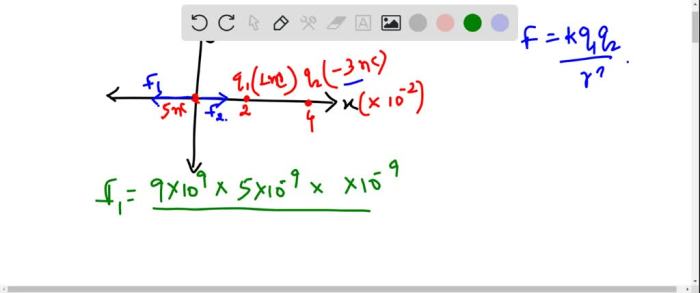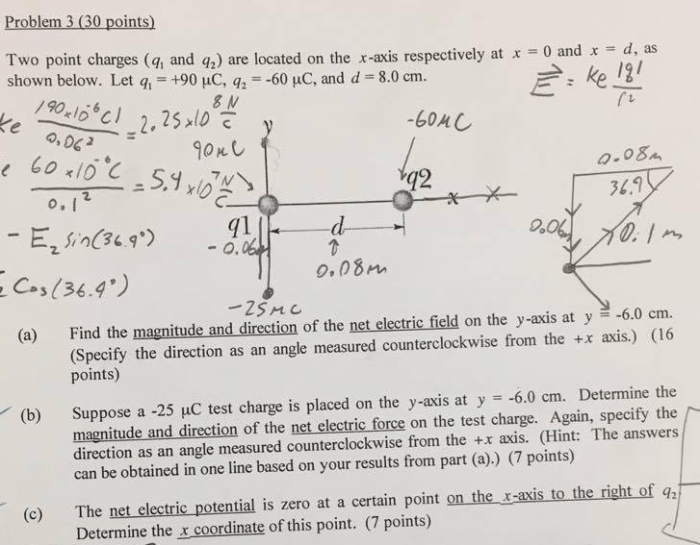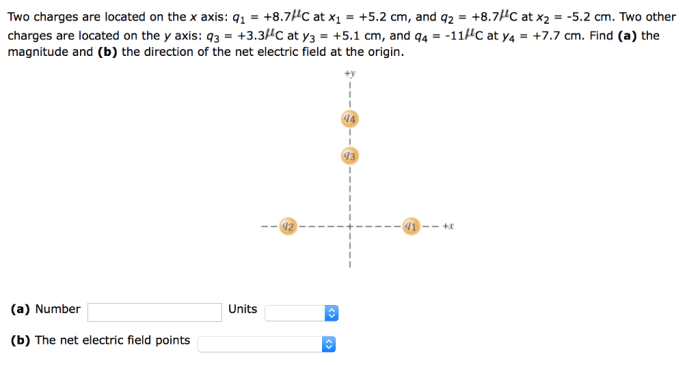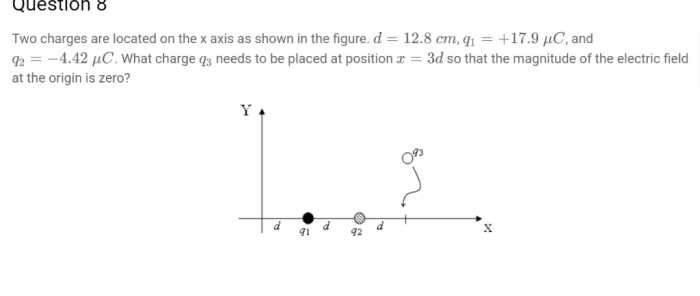Two charges are located on the x axis – When two charges are located on the x-axis, they establish an electrostatic field that governs their interactions. This fundamental concept underlies numerous physical phenomena, ranging from atomic structures to macroscopic systems. In this exploration, we delve into the intricacies of this electrostatic dance, examining the forces, fields, and energies that arise when two charges share the x-axis.
As we embark on this journey, we will uncover the factors that influence the strength and direction of electrostatic forces, unravel the concepts of electric field and potential, and calculate the force and energy associated with two charges on the x-axis.
Along the way, we will encounter real-world applications and examples that illustrate the practical significance of this electrostatic phenomenon.
Overview of Electrostatic Interactions
Electrostatic interactions arise due to the presence of electric charges. These interactions can be attractive or repulsive, depending on the nature of the charges involved. The strength and direction of electrostatic forces are governed by Coulomb’s law, which states that the force between two point charges is directly proportional to the product of the charges and inversely proportional to the square of the distance between them.
Electrostatic interactions play a crucial role in various physical phenomena, including the behavior of atoms, molecules, and macroscopic systems.
Charges on the X-Axis

Consider two charges, q 1and q 2, located on the x-axis at positions x 1and x 2, respectively. The distance between the charges is given by r = |x 2– x 1|.
The electrostatic force between the charges is given by Coulomb’s law:
F = k
- q1
- q 2/ r 2
where k is Coulomb’s constant (k ≈ 8.988 × 10 9N m 2/C 2).
Electric Field and Potential

The electric field (E) at a point due to a single charge q is given by:
E = k
q / r2
The electric field due to two charges located on the x-axis can be calculated by superposition:
E = k
- q1/ (x
- x 1) 2+ k
- q 2/ (x
- x 2) 2
The electric potential (V) at a point due to a single charge q is given by:
V = k
q / r
The electric potential due to two charges located on the x-axis can be calculated by superposition:
V = k
- q1/ |x
- x 1| + k
- q 2/ |x
- x 2|
Force and Energy

The electrostatic force between two charges located on the x-axis is given by:
F = k
- q1
- q 2/ r 2
The potential energy (U) of the system of two charges located on the x-axis is given by:
U = k
- q1
- q 2/ r
Applications and Examples: Two Charges Are Located On The X Axis

The concept of two charges located on the x-axis finds applications in various fields, including:
- Capacitance: The capacitance of a parallel-plate capacitor can be calculated using the formula C = εA/d, where ε is the permittivity of the dielectric material, A is the area of the plates, and d is the distance between the plates.
- Electrostatic lenses: Electrostatic lenses are used to focus charged particle beams in electron microscopes and mass spectrometers.
- Atomic and molecular physics: The electrostatic interactions between atoms and molecules determine their structure and properties.
Expert Answers
What factors determine the strength and direction of electrostatic forces between two charges?
The strength of the electrostatic force is directly proportional to the magnitude of the charges and inversely proportional to the square of the distance between them. The direction of the force is along the line connecting the charges, repulsive if the charges have the same sign and attractive if they have opposite signs.
How do you calculate the electric field due to two charges on the x-axis?
The electric field at a point on the x-axis due to two charges q1 and q2 located at x1 and x2, respectively, is given by E = k – (q1 / (x – x1)^2 – q2 / (x – x2)^2), where k is the Coulomb constant.
What is the potential energy of a system of two charges on the x-axis?
The potential energy of a system of two charges q1 and q2 on the x-axis is given by U = k – q1 – q2 / (x2 – x1), where k is the Coulomb constant and x2 – x1 is the distance between the charges.